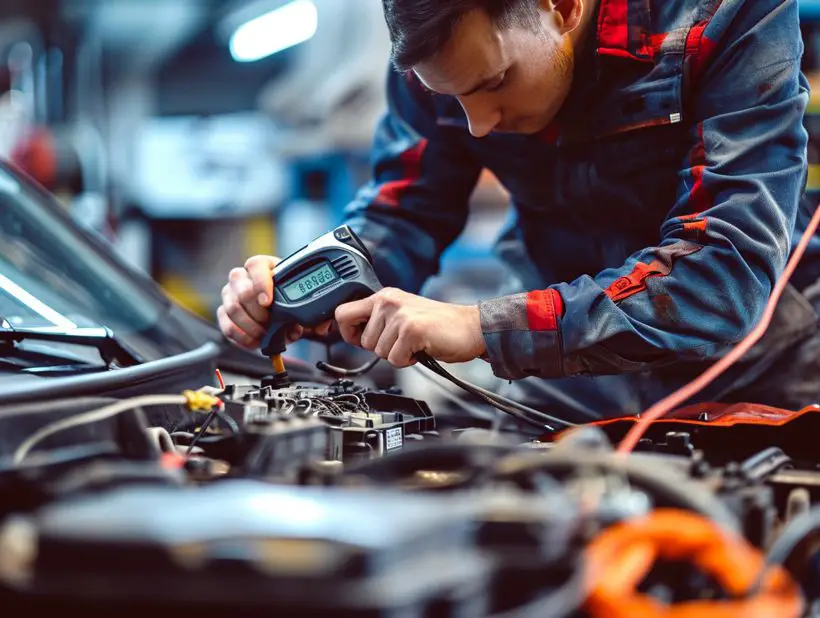Ever noticed your steering wheel shaking as you hit the highway speeds? It’s not just annoying; it can be a sign of underlying issues with your vehicle’s wheel balance. I’ve been there, and trust me, it’s something you’ll want to address sooner rather than later.
I’ll walk you through the common causes of a shaking steering wheel and how to pinpoint the problem. Understanding the root cause is key to a smooth, safe drive, and I’m here to help you get back to that comfortable ride you deserve. Let’s dive into diagnosing those pesky wheel balance problems and get you back on the road with confidence.
Common Causes of Shaking Steering Wheel at High Speeds
When you’re cruising along the highway and your steering wheel begins to quiver, it can be disconcerting. I’ve discovered that there are several typical culprits behind this unnerving phenomenon.
Imbalanced Wheels are often to blame for a shaking steering wheel. This imbalance occurs when the weight of the wheel and tire isn’t evenly distributed. It causes the wheel to bounce or spin with a wobble at higher speeds, which in turn shakes the steering wheel. Regularly getting your tires balanced can prevent this issue.

Another leading cause is Worn Suspension Components. The suspension system, including parts like tie rods, ball joints, and bushings, ensures that your car rides smoothly. If these parts wear out, it can lead to instability in the steering system, manifesting as a shake or shimmy.
Misalignment of the wheels is another factor that shouldn’t be overlooked. If your car’s wheels aren’t aligned correctly, it might pull to one side or another; this can also cause the steering wheel to shake. Wheel alignment is a precise science, and I always recommend having a professional check it regularly.
Brake Issues can also be at fault. If your car shakes more when you apply the brakes, the problem could be with warped brake rotors or deteriorated brake pads. Both of these conditions can cause a palpable tremble through the steering wheel.
Lastly, don’t ignore Faulty Wheel Bearings. These crucial components help your wheels spin freely with minimal friction. When they’re damaged, each rotation can send vibrations through the car, up the steering column, and into your hands.
| Potential Cause | Effect on Steering Wheel | Suggested Action Item |
|---|---|---|
| Imbalanced Wheels | Bounces or wobbles, causing shakes at high speeds | Tire balancing |
| Worn Suspension | Instability and shimmying | Replace suspension parts |
| Misalignment | Pulling to a side, leading to shaking | Wheel alignment |
| Brake Issues | Vibrations when braking | Check/replace brake components |
| Faulty Wheel Bearings | Vibrations with each wheel rotation | Inspect/replace wheel bearings |
Signs and Symptoms of Wheel Balance Problems

When driving, the smallest issues can have noticeable effects, such as wheel balance problems that manifest through various signs and symptoms. As someone who’s experienced these issues firsthand, I know they should never be ignored. In fact, recognizing them early could save you from more costly repairs down the road.
Firstly, vibration is the most common symptom people report. When the wheels are out of balance, they cause the steering wheel to shake, often becoming more pronounced as speed increases. This isn’t just uncomfortable‚Äîit can also be a distraction and a safety concern.
Another telltale sign is uneven tire wear. When I inspect my tires and notice that they’re wearing down irregularly, it’s often a sign that the wheels aren’t balanced properly. One side may be more worn than the other, indicating that the weight distribution isn’t even.
In addition to these symptoms, you might also hear unusual noises coming from the tires. A thumping or humming sound can develop as a result of imbalance, which I’ve found to be particularly noticeable when I’m driving on a smooth road.
Lastly, poor wheel balance can lead to decreased fuel efficiency. If the imbalance is causing the car to work harder, it’ll naturally consume more fuel. This is subtle and can go unnoticed until you start wondering why your fuel tank seems to empty quicker than usual.
Remember, these issues don’t just disappear and often worsen if not addressed. So if you’re noticing any of these symptoms, it’s probably time to get those wheels checked and balanced. It’s an integral part of vehicle maintenance that ensures safety and optimizes performance.
Importance of Addressing Wheel Balance Issues
When I’m behind the wheel, I want my drive to be as smooth as possible. Understanding the implications of ignoring wheel balance problems isn’t merely about comfort; it’s also about safety and long-term vehicle well-being. Let‚Äôs dive deeper into why addressing wheel balance issues is non-negotiable.
Initially, there’s the matter of safety. An imbalanced wheel causes vibrations that may lead to a loss of control, especially at high speeds, and this could result in dangerous driving situations. The vibrations felt are warning signs, and I’ve learned that these shouldn’t be taken lightly. They hint at underlying instabilities in the wheel assembly that, if left unchecked, can escalate quickly.

Moreover, it’s not just the risk of accidents that should urge us to act. There’s also the cost factor. An imbalanced wheel puts uneven pressure on tires, leading to premature wear. I know that replacing tires isn’t cheap, so it makes sense to prolong their life by addressing the balance issues at the earliest. And it doesn’t end with tires ‚Äì the undue stress also affects suspension, bearings, and the steering system. This cascade of potential issues could mean unexpected and costly repairs down the line.
Balanced wheels contribute to better fuel efficiency as well. A car with wheel balance issues requires more energy to overcome the vibrations and rolling resistance. It’s a small difference at first, but when I calculate the costs over time, the extra fuel adds up, making it more expensive to keep ignoring the balance problems.
Keeping an eye on wheel balance also ensures a comfortable ride. The constant trembling transmitted through the steering wheel to my hands can quickly turn a pleasant journey into an exhausting one. Reduced vibrations mean less strain for me and my passengers, and also less noise, which makes for a serene and enjoyable drive.
In all, the timely rectification of wheel balance issues is a triple win: it enhances safety, conserves vehicle longevity, and optimizes performance. Through regular maintenance and immediate attention to emerging issues, I ensure my vehicle remains reliable, responsive, and efficient.
DIY Methods to Diagnose Wheel Balance Problems
When my steering wheel started shaking, I knew it was time to check the balance of my wheels. With the right techniques, I found that even car owners without much mechanical experience can pinpoint what might be wrong. Here’s how I approached the diagnosis process.
First, I inspected the tires for obvious signs of wear or damage. Uneven tread wear can indicate balance issues and can often be spotted with a visual check. I looked for bulges, cuts, and abnormal flat spots which are clear indicators that a tire may be compromised and potentially causing that dreadful wobble.

Next, I performed a simple test in a safe, empty space like a large parking lot. I accelerated gradually to a higher speed where the shaking previously occurred, being sure to maintain a consistent speed to assess the severity of the shake. It’s important to remember that safety always comes first, so I made sure it was a controlled environment and that I was ready to slow down if the shaking became too dangerous.
For more precise DIY methods, I invested in a set of wheel weights and a portable wheel balancer – tools that can be quite affordable for the enthusiastic car owner. By following the manufacturer’s instructions, I attached the wheel weights temporarily to see if the balance improved. This hands-on approach gave me a better feel for which wheel might be causing the issue.
However, wheel balancing is often more complex than just adding weights. I learned that tires should be removed from the vehicle and placed on a professional wheel balancing machine for an accurate diagnosis. While this machine is generally found in auto shops, rental options are sometimes available for those who prefer to handle things personally.
I also checked the tire pressures with a quality gauge, as incorrect tire pressure can mimic the symptoms of an imbalanced wheel. My car’s manual provided the proper inflation levels, and maintaining those levels is crucial for obtaining an accurate read on the balance situation.
Armed with this information, I was able to take proactive steps toward addressing my car’s issues. While these DIY methods can reveal potential problems, it’s also true that some issues require professional equipment and expertise. If after my initial checks the problem persisted, I planned to take my car to a certified mechanic to rectify the situation. This two-tiered approach‚Äîstarting with DIY analysis followed, if necessary, by professional assessment‚Äîensured that I handled my wheel balance concerns effectively and responsibly.
Professional Solutions for Wheel Balancing
After trying out the DIY diagnostics, it’s not unusual to feel the need for a more thorough investigation. Sometimes, even after leveling the wheel weights and ensuring proper tire pressure, the steering wheel shakes persist. That’s my cue to head to the pros. Wheel balancing at a reputable service center involves precision tools and equipment that go beyond the scope of home setups.
Mechanics use high-tech balancers which detect minuscule imbalances that would be imperceptible during a DIY attempt. This equipment effortlessly pinpoints problematic areas, offering a clear path to resolution. I’ve learned that this accuracy isn’t just luxury; it’s essential for modern vehicles, especially those with sensitive steering systems.
In addition to balancing, alignment checks are a cornerstone of professional wheel maintenance. I know that proper alignment ensures my wheels are pointing in the right direction and are parallel to each other. This process includes adjusting the angles of the wheels so that they make optimal contact with the road, reducing tire wear, and ensuring that my car isn’t pulled to one side.

Here’s a snapshot of a professional wheel diagnosis and alignment process:
- Vehicle mounting on an alignment rack
- Connecting reflective clamp to wheels
- Infrared cameras reading wheel alignment
- Computerized adjustments for precise alignment
During my visits, I’ve observed that technicians often advocate for rotating tires as part of the service. This extends the lifetime of my tires by ensuring even wear and can be an opportune time to balance and align the wheels.
Remember, the goal here is not just to curtail the tremor in the steering wheel but to optimize my vehicle’s longevity and performance. What’s more, there could be other underlying issues, and a professional has the right tools to inspect suspension components, steering systems, and even brakes for potential contributors to the issue. Sometimes it’s a combination of factors that, once addressed, can significantly enhance my driving experience.
Having entrusted my car to professionals, I’ve consistently noticed improvements not only in ride comfort but also in fuel efficiency. Their expertise often sheds light on hidden problems that I wouldn’t catch, ensuring that every journey is smoother and safer.
Conclusion
Feeling your steering wheel vibrate can be unsettling but it’s a clear signal to take action. I’ve outlined the key culprits behind this unnerving experience and stressed the importance of not ignoring it. Remember it’s not just about comfort‚ it’s about safety and the longevity of your vehicle. Professional wheel maintenance is the way to go. They’ll not only balance your wheels with precision but also catch any underlying issues before they escalate. So don’t wait until your next scheduled service. If your steering wheel is telling you something’s off take it seriously and get it checked out. Your car and your peace of mind will thank you for it.
